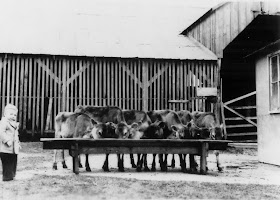Jackie James (SLHS '57) sent me a note recently saying she's enjoyed recent photos relating to the Sugarland Industries. Her father was President of the Industries, as it was known to most old timers, so she has a natural interest in its role in the story of Sugar Land. Imperial Sugar was the town's show piece, so many people, especially new residents, are unaware of the important role the Industries played in Sugar Land's history. A walk through the history of the Industries may be helpful to readers of this blog.
Part 1 starts with early corporate history and the inter-relationship of the Industries and Imperial. Part 2 will cover subsequent developments through the 1970s when the Industries ceased to exist. Part 3 will describe the various businesses operated as subsidiaries under the Industries umbrella over the years.
Part 1 starts with early corporate history and the inter-relationship of the Industries and Imperial. Part 2 will cover subsequent developments through the 1970s when the Industries ceased to exist. Part 3 will describe the various businesses operated as subsidiaries under the Industries umbrella over the years.
Most of my information comes from Bob Armstrong's book, "Sugar Land, Texas and The Imperial Sugar Company." If you have an avid interest in our local history, his book is well worth reading. Copies are available at the Sugar Land Museum.
We'll start at the beginning of the last century. The Cunningham Plantation and the adjoining estate known as the Ellis Plantation, or Sartartia, were in dire financial trouble. Both were bankrupt and run by boards of receivers by 1905. The primary debt holder for both properties was Lincoln Trust & Title Company of St. Louis, Missouri. Its President was A. A. B. Woerheide, who took a very active interest in troubled loans Lincoln had made in our part of Texas. As primary debt holder he led the search for suitable candidates to take over the Ellis and Cunningham Plantations and enable him to remove them from Lincoln's bad loan list.
We'll start at the beginning of the last century. The Cunningham Plantation and the adjoining estate known as the Ellis Plantation, or Sartartia, were in dire financial trouble. Both were bankrupt and run by boards of receivers by 1905. The primary debt holder for both properties was Lincoln Trust & Title Company of St. Louis, Missouri. Its President was A. A. B. Woerheide, who took a very active interest in troubled loans Lincoln had made in our part of Texas. As primary debt holder he led the search for suitable candidates to take over the Ellis and Cunningham Plantations and enable him to remove them from Lincoln's bad loan list.
Woerheide first met W. T. Eldridge roughly a decade earlier in Eagle Lake, when he helped Eldridge and his partner W. E. Dunovant organize the Cane Belt Railroad and their extensive (and very profitable) farming and ranching enterprise at Bonus. Eventually, Woerheide met I. H. Kempner, who had expanded the family empire by purchasing properties in Brazoria and Fort Bend Counties. Both Kempner and Eldridge were interested in acquiring troubled properties in central Fort Bend County, so Woerheide invited both men to serve on the board of Cunningham Sugar Company.
 |
| W. T. Eldridge, Sr. |
 |
| I. H. Kempner, Sr. |
 |
| (This is a very general and approximate diagram of the Ellis (Sartartia) and Cunningham Plantations. It provides a rough idea of the locations for the old properties and current subdivisions.) |
In 1908 they sold the Ellis Plantation to the State of Texas for use as a prison farm. The sale brought Kempner & Eldridge much needed working capital, but it didn't change the corporate name or structure of their partnership in any formal way.
 |
| The Cunningham Refinery and the General Offices for the Sugarland Industries and Imperial Sugar Company. |
Now for the big issue: Why was it named Sugarland Industries rather than Sugar Land Industries? The answer to that question goes back to the town's original name. Apparently, Sugar Land (as two words) was how the Terry and Kyle families referred to their plantation when they acquired it from Nathaniel Williams in 1852/3. Williams had called it Oakland, but the new owners wanted to start afresh with a new name. Imperial Sugar's archives contain a letter written in 1857, whose return address is "Sugar Land." Over time, there appears to have been some confusion about how Sugar Land was spelled, but we have strong evidence of how the founders spelled it.
In 1919 the incorporation papers were drawn up and filed in Delaware. There's good reason to think the Delaware-based lawyer simply made a mistake, because the legal documents show the company name as one word. It has been Sugarland Industries and Sugar Land, Texas ever since.













































